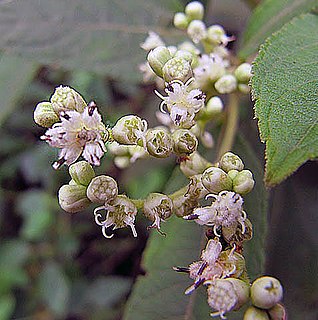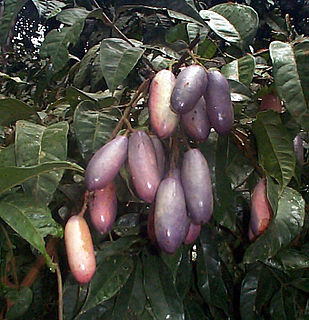
Theobroma is a genus of flowering plants in the mallow family, Malvaceae, that is sometimes classified as a member of Sterculiaceae. It contains roughly 20 species of small understory trees native to the tropical forests of Central and South America. The generic name is derived from the Greek words θεός (theos), meaning "god," and βρῶμα (broma), meaning "food". It translates to "food of the gods."
The Smithsonian Tropical Research Institute is located in Panama and is the only bureau of the Smithsonian Institution based outside of the United States. It is dedicated to understanding the past, present, and future of tropical ecosystems and their relevance to human welfare. STRI grew out of a small field station established in 1923 on Barro Colorado Island in the Panama Canal Zone to become one of the world's leading tropical research organizations. STRI's facilities provide for long-term ecological studies in the tropics and are used by some 1,200 visiting scientists from academic and research institutions around the world every year.

Perrottetia is a genus of flowering plants in the family Dipentodontaceae described as a family in 1824. Species occur in China, Southeast Asia, Papuasia, Hawaii, Australia, and Latin America. It is the largest genus of the recently described order Huerteales.

Weinmannia is a genus of trees and shrubs in the family Cunoniaceae. It is the largest genus of the family with about 150 species. It is also the most widespread genus, occurring in Central and South America including the Caribbean, Madagascar and surrounding islands, Malesia and the islands of the South Pacific. It is absent from mainland Africa and Australia, but some fossils have been attributed to Weinmannia in Australia. Leaves are simple or pinnate, with a margin usually toothed, and interpetiolar stipules. Flowers are bisexual, white, arranged in racemes. The fruit is a capsule opening vertically from the top to the base. Seeds hairy without wings.
Poulsenia is a monotypic genus of trees in the family Moraceae. The only species is Poulsenia armata, native to rainforests from Mexico south to Bolivia.

Clibadium is a genus of flowering plants in the sunflower family.

Mutisia is a genus of flowering plant in the mutisia tribe within the sunflower family. Mutisia has been named after José Celestino Mutis. It comprises about sixty species which can be found along the entire length of the Andes and in southern Brazil, Paraguay, Uruguay and northern Argentina.
Talamancalia is a genus of flowering plant in the family Asteraceae. It contains the following species:

Brunellia is a genus of trees. They are distributed in the mountainous regions of southern Mexico, Central America, West Indies, and South America. Brunellia is the only genus in the family Brunelliaceae. As of 2001 there were about 54 species.
Euplassa is a genus of flowering plants in the protea family.

Espeletia, commonly known as 'frailejones', is a genus of perennial subshrubs, in the sunflower family. The genus, which is native mainly to Colombia, Venezuela and Ecuador, was first formally described in 1808. The genus was named after the viceroy of New Granada, José Manuel de Ezpeleta.

STRI, formerly the Sports Turf Research Institute, is a global design and consultancy specialist for the development of elite standard sports surfaces, based in St Ives, Bingley, West Yorkshire, England. Providing advice and expertise on the research, design, construction and management of both natural and artificial sports fields of play across the world.
Myriactis is a genus of flowering plants in the aster tribe within the sunflower family.

Lasiocephalus is a genus of South American flowering plants in groundsel tribe within the sunflower family. The genus was shown to be part of Senecio and predominantly occurs in tropical alpine-like regions.
Paracalia is a genus of South American flowering plants in the groundsel tribe within the sunflower family.

Dacryodes is a genus of about 60 species of trees in the family Burseraceae. The generic name is from the Greek dakruon meaning "tear(drop)", referring to how resin droplets form on the bark surface.

Chaptalia is a genus of flowering plants in the daisy family.

The Stri Parva, or the "Book of the Women," is the eleventh of eighteen books of the Indian Epic Mahabharata. It traditionally has 4 sub-books and 27 chapters, as does the critical edition.

Loricaria is a genus of South American flowering plants in the pussy's-toes tribe within the sunflower family.

In the Hindu epic Mahabharata, the marital life of the warrior Karna is hardly mentioned. The name of his wife is never revealed but she is mentioned by Karna and Gandhari in the Udyoga Parva and the Stri Parva of the epic respectively. In the Udyoga Parva, Karna states that he married woman chosen by Adhiratha, his foster father. In the Stri Parva, Gandhari describes her to be the mother of Vrishasena and Sushena. It is never cleared whether Karna had one wife or two wives.














